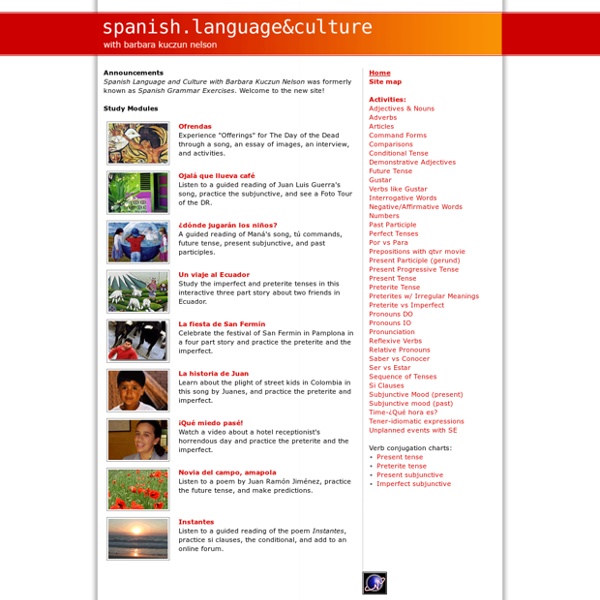27 canciones para aprender español
¿Aprendes español? ¿Te gusta la música en español? Si es así, no te pierdas este listado de canciones para niveles con las que puedes practicar una gramática o vocabulario específicos en español. Gracias a la música puedes memorizar palabras nuevas, estructuras, mejorar tu pronunciación y lo mejor de todo, ¡pasártelo muy bien mientras aprendes!
Spanish Proficiency Exercises
Spanish Proficiency Exercises is a compilation of brief video clips in which native speakers of Spanish from various locations throughout Latin America and Spain demonstrate various language tasks. The objective of the exercises is to provide students of Spanish with the necessary tools to be able to talk about the same topics in Spanish. In order to do, this Spanish Proficiency Exercises contains five major components. First, there is a simplified video clip.
Publicaciones
Acti / España: Revista de Auxiliares de Conversación Acti / España es una publicación anual que recoge un conjunto de actividades creadas por auxiliares de conversación y destinadas a motivar e implicar al alumnado de español del Reino Unido e Irlanda. Lo más destacable de esta revista es el ingenio de sus autores para crear actividades que, a la vez que cubren una parte del currículo, entretienen, son flexibles en cuanto a tiempo y nivel y presentan la realidad española actual, por lo que constituyen un excelente banco de materiales para este profesorado. Últimos números: Acti/España 17 (2013)
Más arriba: Spanish Language Exercises
Más arriba (©2013 by Gary Aitken) is an interactive workbook of introductory Spanish language exercises, based on the pictorial contextualization of fundamental vocabulary and language points. The exercise material includes full-colour drawings, sound clips, instant feed-back, vocabulary help and a voice recorder (powered by Vocaroo). Más arriba can be used with any introductory approach. You can follow the alphabetical Exercise Index directly below or click here to go to the Lesson Index, provided for users of the Third Canadian Edition of ¡Arriba! Comunicación y cultura (©2013 by Pearson Education Canada). Click here to learn how to type accents in Spanish.
Spanish Language & Culture
Home Activities: Adjectives & Nouns Adverbs Articles Command Forms Comparisons Conditional Tense Demonstrative Adjectives Future Tense Gustar Verbs like Gustar Interrogative Words Negative/Affirmative Words Numbers Past Participle Perfect Tenses Por vs Para Prepositions with qtvr movie Present Participle (gerund) Present Progressive Tense Present Tense Preterite Tense Preterites w/ Irregular Meanings Preterite vs Imperfect Pronouns DO Pronouns IO Pronunciation Reflexive Verbs Relative Pronouns Saber vs Conocer Ser vs Estar Sequence of Tenses Si Clauses Subjunctive Mood (present) Subjunctive mood (past) Time-¿Qué hora es? Tener-idiomatic expressions Unplanned events with SE Verb conjugation charts: Present tense Preterite tense Present subjunctive Imperfect subjunctive
The Best Tools For Creating Fake “Stuff” For Learning
The fake “stuff” I’m referring to in the headline includes newspaper articles, sports “trading cards,” iPhone conversations, Facebook pages etc. These can be used for conversation practice, to create reports on historical figures (or on natural disasters or on just about anything) and for numerous other learning activities. Here are my choices for The Best Tools For Creating Fake “Stuff” For Learning: Boy, this could be a great tool to help English Language Learner students practice writing and reading dialogue — FakeiPhoneText lets you create a text conversation that looks like the real thing and give you a unique url address of your creation.
How to teach conversational lessons
Hello, there. This post was written to share my favourite resources aimed at conversational lessons – both online and face-to-face. I hope you find it useful. The first minutes of the lesson are meant to arouse your students’ interest.
8 Google Chrome Extensions you “Add”solutely Need to Use if you are a Teacher
I have been struggling with the title of this post. I wanted to write it in capital letters and tried different angles, all with the same purpose, trying to entice you into reading it as I know for certain that, for some teachers out there, add-ons ( also known as extensions) are still unknown. Introduction Working as a “free app” teacher trainer has taught me quite a lot of things. I have seen that, contrary to my initial belief, most teachers are not afraid of introducing technology in their classes, they just don’t know how to do it or where to get started. Once they realize how easy it is to create their own activities, how little effort it takes to create meaningful activities for their classes using the feared apps, there is no ending to their requests to learn more and more, which is just awesome!
18 Free Image Sites and Tools for Schools
A picture is worth a thousand words, but it might also be worth a thousand dollars if your school gets hit with a copyright violation claim. This happens to schools every year as students or teachers inappropriately use an image that they do not have the rights to. Thankfully this does not have to be the case as there are loads of high quality pictures that can be used in school projects without any licensing concerns. These can include images that are released under creative commons, or are in the public domain, or simply are copyright-free. Of course depending on the license, it may still be necessary to cite where the image came from to provide proper attribution (and it can be a good practice to do even if not required).



